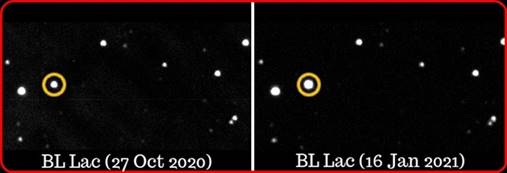Indian Astronomers have reported one of the strongest flares from a feeding supermassive black hole or blazar called BL Lacertae. Analysis of the flare from this blazar, one of the oldest astronomical objects, can help trace the mass of the black hole and the source of this emission. Such analysis can provide a lead to probe into mysteries and trace events at different stages of evolution of the Universe.
Blazars or feeding supermassive black holes in the heart of distant galaxies receive a lot of attention from the astronomical community because of their complicated emission mechanism. They emit jets of charged particles traveling nearly at the speed of light and are one of the most luminous and energetic objects in the Universe.
BL Lacertae blazar is 10 million light-years away and is among the 50 most prominent blazars that can be observed with the help of a relatively small telescope. It was among the 3 to 4 blazars that was predicted to be experiencing flares by the Whole Earth Blazar Telescope (WEBT), an international consortium of astronomers.
A team of astronomers led by Dr. Alok Chandra Gupta from Aryabhatta Research Institute of Observational Sciences (ARIES), an autonomous institute of the Department of Science & Technology, Government of India who had been following the blazar since October 2020 as part of an international observational campaign detected the exceptionally high flare on January 16, 2021, with the help of Sampurnanand Telescope (ST) and 1.3m Devasthal Fast Optical Telescopes located in Nainital.
The data collected from the flare observed will help calculation of the black hole mass, size of emission region, and mechanism of the emission from one of the oldest astronomical objects known, hence opening a door to the origin and evolution of the Universe.

The luminosity of BL Lac observed on 27 October 2020 (left panel of figure) was around 2.95 * 1012 Lʘ and after 80 days, i.e., 16 January 2021 (right panel of figure) was ~ 7.25 * 1012 Lʘ, i.e., ~ 250% increase in the luminosity which is equivalent to more than 4 trillion Lʘ (here Lʘ = luminosity of the Sun).
The link to Astronomical Telegram #14343 with the announcement of blazar BL Lacertae’s luminosity record: http://www.astronomerstelegram.org/?read=14343

For more details, Dr. Alok Chandra Gupta (Scientist-F) (+91-7895966668, alok@aries.res.in ) can be contacted.
Source:PIB







 Finance
Finance







